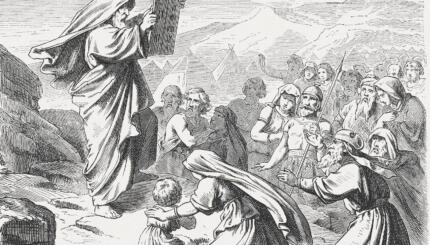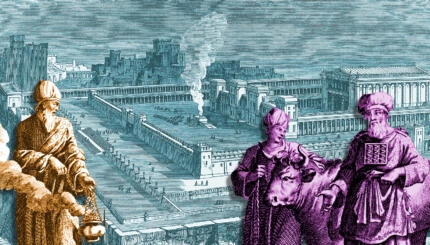Reprinted with the author’s permission from Jewish Law: History, Sources, Principles (Jewish Publication Society).
Joseph Caro’s main objectives in writing his Bet Yosef were to collect into a single work the different opinions concerning the rules of halakhah, and, by means of the methodology he had formulated, to determine which opinion should be accepted as law.
Caro, however, saw this work as only one part of his solution to the problem of codifying Jewish law. He knew that while a book of halakhot (containing a complete discussion of the sources of the law and the views of all the authorities as well as a final normative decision) was essential, it was not itself sufficient to satisfy the needs of halakhic codification. He appreciated Maimonides’ fundamental premise that the essential characteristics of a convenient and efficient code are clarity and brevity–the code must present each law clearly, categorically, and definitively.
Therefore, after composing his Bet Yosef, and as a complement to it, Caro provided Jewish law with a classic book of pesakim–the Shulhan Arukh.
With your help, My Jewish Learning can provide endless opportunities for learning, connection and discovery.
Support for Maimonides’ Method
Caro made his position very clear as to the need for a book of pesakim. Rabad had criticized Maimonides severely for having, in his Mishneh Torah, "forsaken the method of all authors who preceded him" in that Maimonides omitted the sources on which his decisions were based and presented only the view with which he agreed.
Caro responded to Rabad’s strictures as follows:
"But I say that the master’s [Maimonides’] reason was that if he had wanted to follow the method of the authors who preceded him, what purpose would there have been in writing anything beyond what had already been written by Alfasi, whose rulings he generally followed? Therefore, he intended to introduce a new method: to state the law clearly and briefly in the style of the Mishnah, so that every intelligent person thereafter can rely on Maimonides’ statement of the law.
And should some great scholar not be prepared to accept that choice without first weighing the matter himself–who prevents him from studying the talmudic literature and the other halakhic works? It follows that the method Maimonides adopted is of benefit to everyone except the scholar who stands head and shoulders above the rest of his generation–and even for such a person it is of value, because if he must make a quick decision, he can rely on Maimonides’ opinion; and even if he is not pressed for time, it is no small matter for him to know Maimonides’ opinion."
A "Double" Code
Far from contradicting Caro’s methodology in Bet Yosef, his statement quoted above supplies the additional element essential to achieve his overall approach to codification of Jewish law. He believed that a halakhic code must have two components: one that cites all the sources and differing opinions, and another that presents a single statement of the law-final, categorical, and monolithic.
Caro described clearly his theory of the "double" code in his Introduction to the Shulhan Arukh. He began by describing his Bet Yosef:
"The major work that I wrote on the . . . Turim, which I called Bet Yosef, includes all the laws to be found in all the [books of the] codifiers, new and old, together with their sources in the Babylonian and Jerusalem Talmuds, the Tosefta, Sifra, Sifrei, Mekhilta, commentaries, codes, and responsa, new and old, with each law fully and appropriately explained in its proper place."
He continued:
"I realized that it would be beneficial to gather the lilies and the sapphires [i.e., the halakhic conclusions] of its [Bet Yosef‘s] discussion, [and present them] briefly, clearly, and comprehensively, in an elegant and pleasant style, so that God’s perfect Torah may be fluent on the tongue of every Jew. Thus, when a scholar will be asked a matter of halakhah, he will not need to hesitate.
. . . The law to be applied in practice on any question that he will be asked will be clear to him because he will be fully familiar with this book [Shulhan Arukh], which is so excellently constructed. It is divided into thirty parts, so that if one studies one part each day, he will have reviewed its contents every month. Of such a person it will be said, ‘Happy is he who comes here with his knowledge readily in hand.’
Furthermore, the younger students will study it constantly and commit it to memory. Practical halakhah will thus become ‘childhood learning’ absorbed in their earliest years; and when they grow old, it will not depart from them. The intelligent students will shine like the heavens because they will be spared the pain of great toil and will enjoy studying this book; it is entirely pleasurable, containing clear and definitive statements of the applicable law, without discursive debate or argument.
I called this book Shulhan Arukh [The Set Table] because the reader will find set out in it all kinds of delicacies meticulously arranged, preserved, systematized, and clarified. I trust that, by divine grace, the earth will be filled with the knowledge of God by virtue of this book — the small and the great, the student and the accomplished scholar."
This, then, was Caro’s approach to codifying halakhah. Bet Yosef included the disparate opinions on all the laws and their sources; but "so that God’s perfect Torah may be fluent on the tongue of every Jew," Caro composed another book "containing clear and definitive statements of the applicable law, without discursive debate or argument."
This latter work would be written "briefly, clearly, and comprehensively, in an elegant and pleasant style," so that when a judge or scholar is asked a question, "he will not need to hesitate, . . . [and] the law to be applied in practice on any question that he will be asked will be clear to him."
Like all codifiers–in Jewish law as well as in other legal systems–Caro was convinced that not only would his code serve talmudic scholars and experts, but also "the younger students will study it constantly and commit it to memory," so that "practical halakhah will thus become ‘childhood learning.’" Caro’s two-part work–a book of halakhot and a book of pesakim–indeed constitutes the halakhic code par excellence, fully appropriate to the nature, and responsive to the needs, of the halakhah.
Torah
Pronunced: TORE-uh, Origin: Hebrew, the Five Books of Moses.


